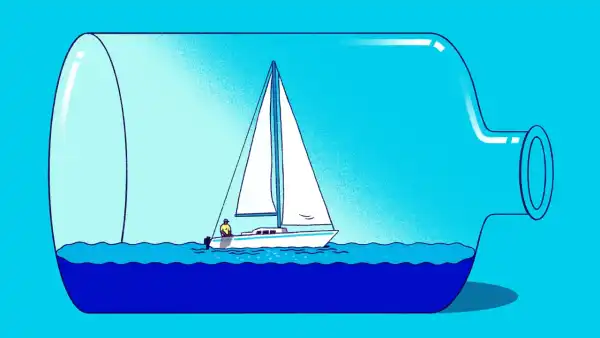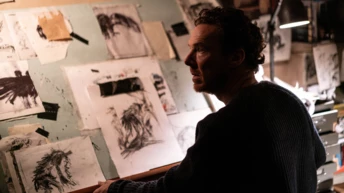
Save this storySave this storySave this storySave this story
I am fond of conversation, and on occasion, when I notice myself rambling, I curtail my verbosity by figuring out a fascination quotient. The F-factor, as I conceptualize it, involves the degree of interest a listener possesses in the discussion compared to the degree of interest the speaker holds in the same topic. Ideally, the quotient is unity: the listener and speaker share an equal fascination in the discourse. However, this value can exceed unity if, by happenstance, you disclose a morsel of gossip whose significance you underestimate. Conversely, it can dip below unity if your discourse is tedious. Should the F-factor persist in its descent, you’re effectively engaged in self-talk.
I posit that few topics elicit a lower F-factor than pastimes. To avert causing offense, I will refrain from itemizing instances where others’ descriptions of their avocations have bored me. However, I can acknowledge that, across the years, I have bored numerous individuals—particularly my spouse—with dissertations on cameras, computers, kayaks, wetsuits, exercise bikes, weight training, e-ink devices, science-fiction tales, Lee Child’s “Jack Reacher” saga, home-brewing kits, miniature synthesizers, electric scooters, timepieces, Japanese outdoor attire, and other interests too mortifying to recount. To my discredit, I’ve even shared anecdotes of dialogues I’ve engaged in with fellow hobby devotees within virtual forums.
The diminished F-factor of hobby parlance mirrors the essence of hobbies. While many exhibit external facets, a hobby ultimately represents self-improvement, pursued out of intrinsic enjoyment. Our culture exalts publicity and output: possibly this explains why hobbies appear to be diminishing. On YouTube, content creators lament that “nobody has hobbies anymore,” and bemoan “the grindification of hobbies”; from their standpoint, we are overly absorbed by our gadgets or side hustles to engage in watercolor painting. In The Atlantic, Tyler Austin Harper observes that “hobby inflation” has escalated the costs of “golf, skiing, indoor climbing, mountain biking, photography, knitting, tabletop games, and theatergoing,” among other recreational pursuits. (Harper identifies several drivers, encompassing tariffs and dynamic pricing; one might append wealth disparity, and the internet’s propensity to synchronize interests.) Moreover, in a milieu defined by maximalism and monetization, it is increasingly difficult to remain an amateur. If we excel at a skill, we aim for total dedication, potentially even monetization. We appear to be distancing ourselves from a way of life where we engage in activities with restraint, merely for pleasure.
Everyone is pressed for time—aren’t we preoccupied, partially, with avocations? What even qualifies as a pastime? “All my pastimes are passive,” a contributor on the forum Ask MetaFilter recently lamented. These encompassed reading, browsing, viewing videos, messaging companions, petting the feline, and embarking “into random research deep-dives.” Plainly, something was lacking; it would be welcome to have conventional hobbies, to “do things such as care for plants, crochet, knit, cook, paint, etc.” Yet, initiating these pursuits proved surprisingly challenging, as they consistently felt contrived. “I simply fail to grasp what prevents me from embodying the kind of individual with practical, fulfilling, soul-enriching pastimes,” the contributor expressed.
The French postmodern intellectual Jean Baudrillard may have possessed a solution. He asserted that we exist within an illusory consumerist illusion, wherein even our passions are pre-selected by marketers. According to this interpretation, capitalism implies that inventive, self-reliant, self-advancing people engage in pastimes, and then grants us a constrained selection of options. We render our choices, solely to discover ourselves indifferent towards the quaint, socially endorsed forms of time-killing in which others evidently channel their vital force. If accurate, it almost suggests that hobbies are intended for the unintelligent. Conversely, perhaps hobbyists are correct, and hobbies are indeed “soul-enriching.” Maybe they contrast, in a significant way, from the non-hobby engagements that occupy our attention. Should this be the case, we might inquire: Why?
Within the timeless juvenile narrative “Ox-Cart Man,” situated in the early nineteenth century, a New England lineage cultivates potatoes, turnips, apples, and cabbages; crafts mittens and weaves shawls; extracts sap from maples, evaporates it into syrup, and packages the resulting sugar; and fabricates candles. Subsequently, the father conveys all their produce and vends it at a marketplace. The family lacks “hobbies,” so far as we discern. A judicious principle is that if necessity dictates an action for survival, it ceases to be a pastime. Hobbies presuppose a specific degree of financial independence; they manifest during discretionary periods, which in turn entail a notion of leisure, contrasting with labor patterns linked to industrialized civilization. Moreover, numerous hobbies are enabled through the affordable commodities that industrialization engenders; they involve purchasing.
It might appear that a consumeristic society characterized by industry should constitute a hobby nirvana. However, hobbies can be stylish, specialized, or unconventional, and their components are frequently sought for purposes other than leisure, potentially inflating costs. During the nineteen-forties, fifties, and sixties, for example, intricate airplane models constructed from balsa wood could retail for under a dollar. However, in ensuing decades, producers integrated balsa wood into composite materials utilized in boats, surfboards, and analogous articles requiring lightweight durability; demand intensified during the twenty-tens, with the proliferation of colossal wind turbines, whose blades are sometimes crafted from synthetic fibre incorporating a balsa-wood core. Presently, most models consist of plastic, and wooden variants command premium prices. More broadly, all physical models have grown costly to fabricate, contrasted with the infinite virtual structures one can erect in virtual environments such as Minecraft.
Shifts in the economy can propel hobbies down convoluted pathways. In the early nineteenth century, candle production was arduous, and demand was robust; therefore, candle-making was a vocation, not a leisure activity. However, only a few decades hence, factories rendered candles inexpensive and ubiquitous. Another hobby precept dictates that once something becomes commoditized, self-production transitions into a source of amusement: therefore, you can nowadays be a hobbyist who pickles her individual cucumbers, processes her individual film, or constructs her individual furniture. Yet, paradoxically, the enhanced value of handcrafted goods can revert hobbies into vocations. Currently, the “Ox-Cart Man” family could vend their merchandise via Etsy. Alternatively, they might inaugurate an artisanal-candle firm, as Jan Levinson endeavors within “The Office”—an amusingly illustrative example of how “grindification” can transform enjoyment into drudgery. In a 2009 essay for the Times, Alex Williams depicted a thirtysomething knitting aficionado who, having relinquished her position at a copy center, managed to generate a six-figure revenue by selling scarves on Etsy. “Envious?” Williams queries, facetiously. “How could one not be? Her pastime constitutes her livelihood.”
Given that numerous hobbies bear resemblance to or adjoin work, a paradox of hobby existence is that engagement may jeopardize conversion into a form of occupation. A dedicated hobbyist seeking to resist this impetus must endeavor for competence devoid of professionalism, inventiveness devoid of productivity, aspiration devoid of anxiety; he must acknowledge when to enunciate, “Sufficient.” A retired neighbor of mine tends to a beautifully maintained garden, and restores a glamorous, properly functioning vintage sports vehicle; he exudes coolness while circumnavigating the neighborhood, and his garden is so luxuriant that occasionally, fellow neighbors ponder engaging his horticulturalists. Should his vehicle function optimally, shouldn’t he refurbish further automobiles? Should he maintain his garden to a professional threshold, is he somehow fulfilling the duties of a landscape professional? A pastime entails an aversion to professionalization—a recognition that, while realizing aspirations is gratifying, so is fantasizing. “I contemplate retiring from music, permitting it to transition into my leisure pursuit,” the musician Grimes suggested some years ago. She has not released an album since.
Suppose that you relish frequenting breweries on weekends, where you sample microbrews, about which your knowledge is extensive. Is attending breweries your pastime? Perhaps you delight in voyaging, devoting months annually to arranging and partaking in excursions; alternatively, you exercise, or concoct elaborate family meals, or devoutly observe baseball. A plethora of individuals are Swifties or foodies. Are all such endeavors hobbies?
Various leisure experiences exist, and implementing even indistinct differentiations is worthwhile. Frequenting breweries may be more appropriately categorized as a diversion, analogous to observing baseball; culinary pursuits might signify a passion; recurrent travelling, a life style. Perhaps embodying a foodie represents an identity as opposed to a pastime: akin to being a devotee (and foodies frequently idolize chefs, establishments, and culinary personalities). An avid reader I know informed me that, for him, reading constituted a “pursuit” as opposed to a pastime.
To a degree, the manner in which you engage matters. Specific types of video gameplay might qualify as a pastime; others could more closely resemble an escapade. I attend the gymnasium each weekday, yet I would not characterize it as a pastime; I conceive of it as an investment, owing to my mid-forties age, young offspring, and desire for sufficient fitness to pursue hypothetical grandchildren. I listen to a substantial volume of music, yet I would categorize music as an interest, or possibly a source of joy. Photography, conversely, constitutes—in my instance—a conventional pastime. I peruse publications, cultivate abilities, trade equipment, establish objectives, and deliberate on diverse photographic quandaries and predicaments in a semi-professional manner that defies strict amateurism.
Occasionally, a pastime can metamorphose into an endeavor motivated by non-hobby impulses. Assembling—be it trading cards, artworks, dinnerware, Labubus—serves as a pastime for many. Yet, within “A Noble Madness: The Dark Side of Collecting from Antiquity to Now,” the historian James Delbourgo postulates that Freud “precipitated an intellectual transformation,” after which “the act of collecting was perpetually concerned with something extraneous, and rarely solely focused on the item accumulated.” (Freud perceived a collector as an individual who projects “surplus libido onto the inanimate object.”) The pursuit of a pastime can at times verge into fixation or compulsion; plausibly, it was from the outset a form of recompense, evasion, illusion, or ego inflation. Numerous grand vessels rarely encounter water.
From the preceding, we might deduce that a pastime should center upon itself, rendering satisfaction straightforwardly and intrinsically, in the action itself, rather than functioning as a circuitous trajectory towards an alternative destination. Adopting a stricter position, we might stipulate that a pastime should not primarily aspire to generate happiness or foster togetherness. Embodiment of virtue does not constitute a pastime; neither does socializing. Pastimes should possess intrinsic captivation.
From this vantage, one indicator of a “genuine” pastime might encompass overproduction. A crocheting association convenes at my local library, whose members crochet so prolifically that the circulation desk features a receptacle overflowing with miscellaneous crocheted artifacts readily available. (My offspring employs a crocheted pencil as a page marker.) Unquestionably, the crocheting circle members derive genuine pleasure from crocheting. Similarly, baking enthusiasts delight so profoundly in baking that they furnish delicacies not merely for their immediate circles, but for colleagues; journaling hobbyists occasionally locate themselves maintaining multiple journals, each subtly distinct, constituting a sophisticated journaling methodology. This amalgamation of limitation and surplus constitutes part of the pleasure of hobbies. In numerous respects, they are defined contrarily, by the avenues that hobbyists consciously avoid. However, this clears terrain for the unrestricted articulation of enthusiasm.
Does a meta-perspective exist wherein possessing pastimes represents a pastime in itself? “For those amongst us who possess ‘hobbies and interests,’ we frequently possess an abundance thereof,” the writer Michael Johnston observed in 2012. Johnston principally authors content pertaining to photography, yet he formerly occupied a role at Model Railroader magazine; he engages in billiards, appreciates high-end audio apparatus, and so forth. Having invested decades within this man-hobby vortex, he proffers a six-phase blueprint for administering and refining personal pastimes. Initially, enumerate all; then, prioritize the enumeration. “Across a span of weeks or months or even years,” occasionally re-prioritize the listing, and ultimately pinpoint “the persistent top three.” Contemplate enhancing engagement with those hobbies while diminishing engagement with the remainder—and, conclusively, articulate for yourself what you find most gratifying within your preferred pastimes. “An individual whose enthusiasm lies in angling might genuinely appreciate tying flies; an individual whose enthusiasm resides in gardening might genuinely derive greater pleasure from the shades of flowers,” Johnston articulates. “I believe you will achieve maximal contentment upon recognizing the precise locus of your enthusiasm, and embracing that, while relinquishing alternative concepts. Should you genuinely venerate flowers for their hues, perhaps you could delve into an area of horticulture where that serves as a pivotal facet, such as hybridizing tulips.”
Johnston observes that hobbyists frequently find themselves governed by “widespread conventional notions” concerning the proper execution of their pastimes. This is reasonably instinctive. Upon initiation, one adheres to the established protocol; one procures the requisite accoutrements and establishes the obligatory objectives, accepting specific assumptions regarding one’s prospective hobby trajectory. The playbook possesses genuine significance; ideally, it should remain concise and delightful, granting autonomy in deriving individual conclusions. Therefore, the internet may have rendered hobbies excessively intricate through a surfeit of knowledge and counsel. Upon initially undertaking photography during secondary schooling, I employed my paternal grandfather’s vintage camera and captured imagery of my peers; during tertiary education, within a photography module, I photographed flora and rail lines. My competence was deficient, yet my enjoyment was abundant. Years hereafter, upon recommencing the pastime a second occasion, I observed countless YouTube tutorials, many produced by seasoned photographers, frequented virtual communities, and allocated exorbitant sums equipping myself with the apparatus prescribed as indispensable by others. I inundated my cognitive faculties with established conventions and aspirations. Complication, as opposed to grindification, served as my nemesis, and I devoted several years in rediscovering the simplicity I had forfeited.
A significant stride for myself transpired during a draughtsmanship workshop I attended, presided over by a British sculptor and artist. She communicated that we would partake in a sequence of sketches, to be shielded from view among our assembly of approximately two dozen individuals. Initially, we sketched a chair, indicated by her upon the platform. Subsequently, we rendered a self-portrait, from memory. Then, we outlined our cranial structures, and populated their interiors with our cognitive processes. The endeavor persisted throughout further sequential phases, for a duration of approximately sixty minutes. My apprehension regarding the cumulative direction of the exercise persisted until its abrupt conclusion. “Recall that this is within your capacity,” she communicated. “You are sanctioned to simply draw. You may allocate an hour solely to drawing.” This represented, to me, a startling assertion, one which has remained enduringly etched within my recollection. Consequently, I have periodically generated sketches, without ulterior motive, absent from audience. Frequently, I have adhered to her straightforward manual.
During the preceding week, I extended assistance at my offspring’s extracurricular chess session, arranging boards, resetting pieces, and generally aiding the instructor in her efforts to preside over an assemblage of second-grade students. She jovially shepherded them into pairs for gameplay, punctuated solely by pronouncements of repositioning, check, checkmate. Observing their engagement, I contemplated prospective eventualities. Some would evolve into “chess prodigies”; others might solely recall chess as a feasible activity. Optimistically, as adults, they would universally perceive their entitlement to engage. The drama endemic to hobby existence emanates, partially, from the necessity of self-granted authorization to pursue desired activities, simultaneous to discernment of personal desires, in tandem with determination of desired cessation. Within an environment characterized by external pressure—dictating workload, rest periods, and pursuit of achievement—hobbies implore individuals to discern and thoughtfully respond to personally evolving inclinations. Hobbies bestow opportunities for self-management and self-awareness. Which is to state that they grant autonomy. ♦
Sourse: newyorker.com







